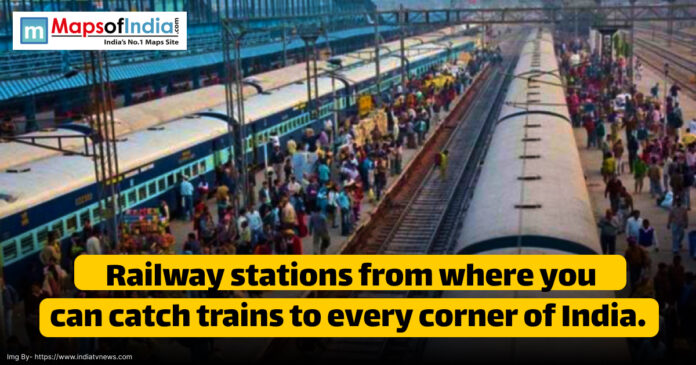India has one of the world’s largest and most intricate railway networks, the backbone of the nation’s connectivity. With over 68,000 kilometres of line stretching from one end of the country to the other, it allows millions of people to traverse the breadth and length of this nation without gaps along a journey through a variety of landscapes. The Indian Railways serves every section of society, from budget travellers to luxury trips making it a part and parcel of the everyday life of the Nation. Due to the size of the country, some of the railway stations became the nerve of vital connectivity to any nook and corner of the country, providing seamless transit for passengers and freight.
Among them, few of the stations have strategic importance, historical significance and unmatched connectivity. These railway stations act as the nerve centres of India’s transportation network, connecting metropolitan cities to remote towns and villages, including New Delhi, Mumbai Central, Howrah and Chennai Central. They make travel across different terrains; from the snow-clad Himalayas to the coastal hinterland of the south; possible. If you wish to reach any corner of beautiful India, railway stations act as one of the primary entrances that make your exploring possible, and this article will tell you about some of the most important Railway stations in India.
New Delhi Railway Station (NDLS): The Northern Nexus
Located at the centre of our nation’s capital, New Delhi Railway Station is among the major and busiest connectivity nodes in India. The train, which is also the starting point for the coveted Rajdhani Express, serves to efficiently commute the capital with other important state capitals over long distances. It also serves as a host for multiple Shatabdi Express trains, ensuring fast regional connection. Truly a national nexus, NDLS has over 250 trains running through it on an average day, making it well-connected in the eastern, western, northern, and southern directions.
Mumbai Central Railway Station (MMCT): The Western Gateway
Mumbai Central Railway station is one of the vital terminals on the Western Railway line, sitting in the busy city of Mumbai. Established in 1930, the station has a deep-rooted history and evolved as one of the significant junctions connecting Mumbai to the rest of India. It is the originating station for many long-distance trains travelling to the northern, western, and north-western parts of India, including the premium Mumbai Rajdhani Express. Thanks to its prime location and full-connectivity nature, the station is an essential stop for any traveller wishing to pass from one country’s end to another.
Chennai Central Railway Station (MAS): The Southern Bastion
Chennai Central is an imposing gateway to southern India a strategic location, it is well connected to the northern, eastern and western regions of the country. The station manages around 400 trains a day, including 86 pairs of mail and express trains, plus a large volume of suburban services. The ability of IRCTC to handle such a large number of trains and passengers highlights its central role in facilitating travel across the length and breadth of India.
Howrah Junction (HWH): The Eastern Emissary
Howrah Junction in Kolkata is one of the oldest and busiest railway stations in India and a major gateway to the eastern and northeastern states. It has almost a million platforms and a huge network of trains running to nearly every part of the country. Trains originating from Howrah touch upon the length and breadth of India, on northern, southern, western and extreme northeastern destinations, thereby forming an integral hub for pan-Indian travel.
Secunderabad Junction (SC): The Central Link
Secunderabad Junction is a major rail hub in central India and is based in the city of Hyderabad. Its location also allows for quick and easy access to the north, south, east, and west. The station processes thousands of trains every day serving superfast and express services to and from the largest cities and furthest rural regions. Its position as a central connector is a testament to its significance in the Indian railway network.
Mughalsarai Junction (MGS): The Strategic Crossroad
Now called Pt. Deen Dayal Upadhyaya Junction, this station in Uttar Pradesh is one of the busiest in India. Located on the Grand Chord route, its position serves as a crucial artery facilitating transit throughout the country’s eastern and northern regions. The train station set here is a crossroad of sorts, with dozens of trains running through a day, linking the country’s northernmost and southernmost reaches a testament to its strategic positioning as the key junction in India’s much-written-about railway system.
Ahmedabad Junction (ADI): The Western Splendour
Ahmedabad Junction is the main railway station serving the state of Gujarat, India, linking western India with the rest of the nation. The station operates a huge variety of trains, including long-distance express services connecting to the north, south, and east of the country. The city is also a crucial juncture for connoisseurs eager to visit all parts of India, given its extensive connectivity.
Patna Junction (PNBE): The Eastern Pivot
Patna Junction, a major railway junction in eastern India, is located in the capital of Bihar. This station has wide access to northern, western, and southern regions, pulling in many trains per day. Moreover, the strategic positioning of the station makes it an essential transit zone for the passengers travelling between different zones of the country establishing its significance as an eastern pivot in the railways.
Bhopal Junction (BPL): The Hub at the Heartland
Bhopal Junction is a vital rail station in central India. The station manages a high number of trains, from the well-known Shatabdi Express, and has trips to northern, southern, eastern and western sections of the country. It is centrally located and serves as an important transit point for passengers travelling to other parts of India.
Jaipur Junction (JP): The Desert Gateway
The station consolidates the honey and sugar desert state of Rajasthan to various parts of India. Many trains are set in motion every day via the station; with connections to the south, east, west, and north. Owing to its strategic location and seamless connectivity, it is certainly a must-stop for travellers visiting the diverse terrains of India.
Conclusion
More than mere transit points, India’s railway stations are lifelines of people, cultures and economies over the subcontinent. For people travelling to the desert of Rajasthan, the tea garden of Assam, the busy market of Kerala, or a hill station of Jammu and Kashmir, trains would be there to serve them, thanks to railway stations such as New Delhi, Howrah, Chennai Central, and Mumbai Central. These stations, and associated infrastructure, not only transport millions of passengers daily, they also enable the movement of goods, making them pivotal to India’s economy and development.
While India is also modernising its railway network by introducing high-speed trains, digital ticketing solutions, and better facilities, these major railway stations will continue to serve as pivotal points for the next phase of the country. They’re important not just as transportation, but also as an emblem of India’s unity in diversity, bringing together people from a vast array of backgrounds, languages, and traditions.





